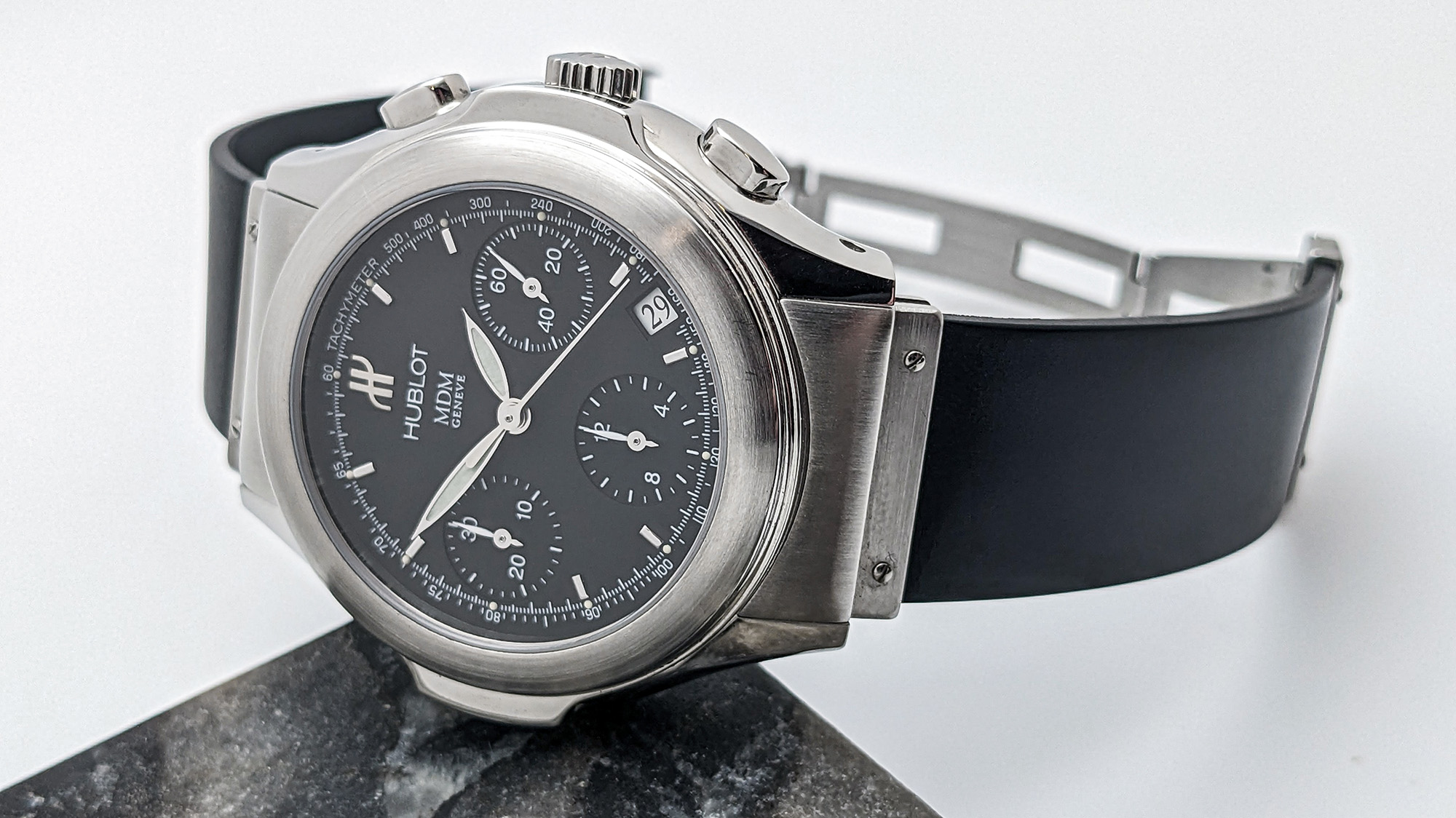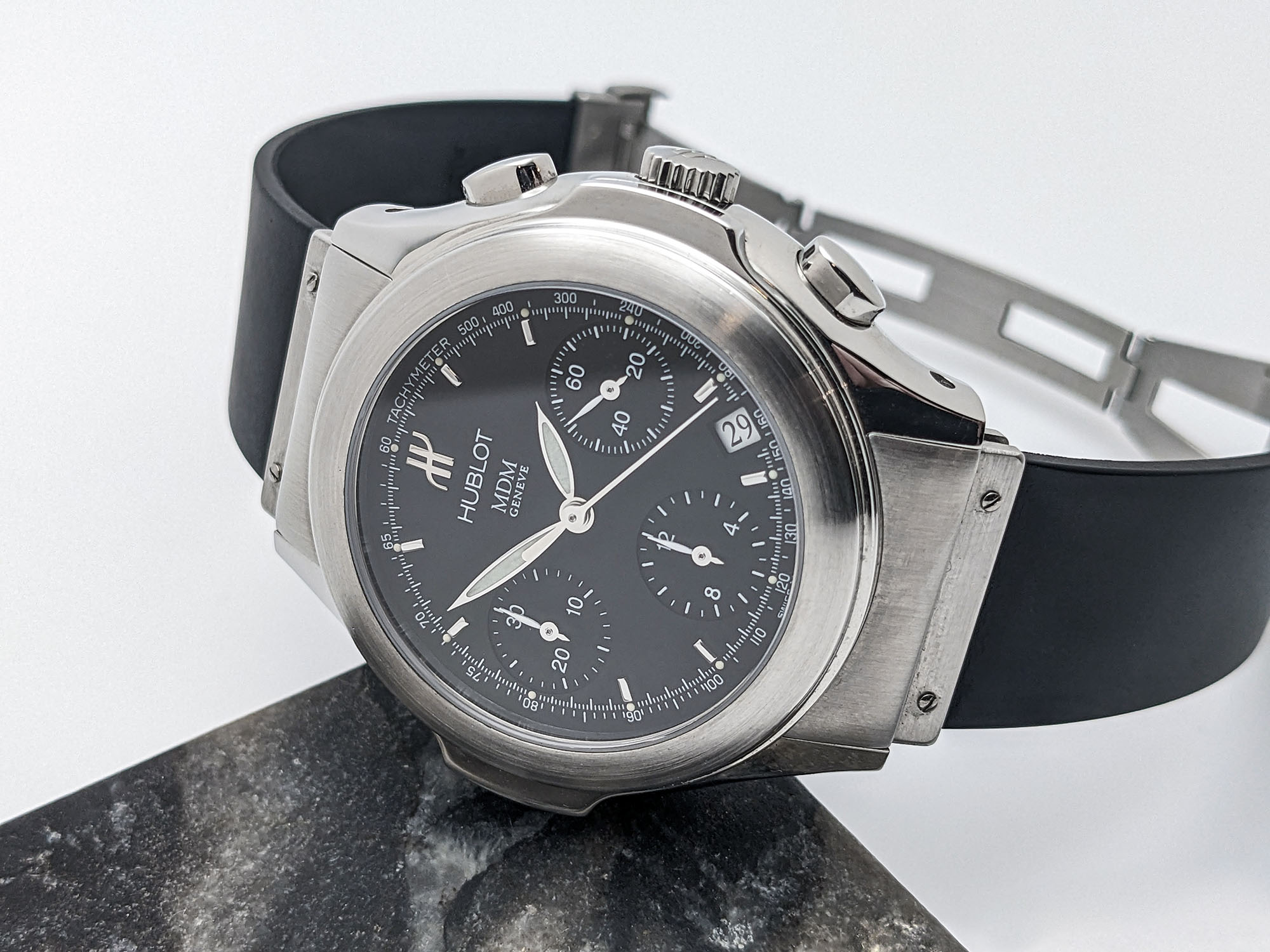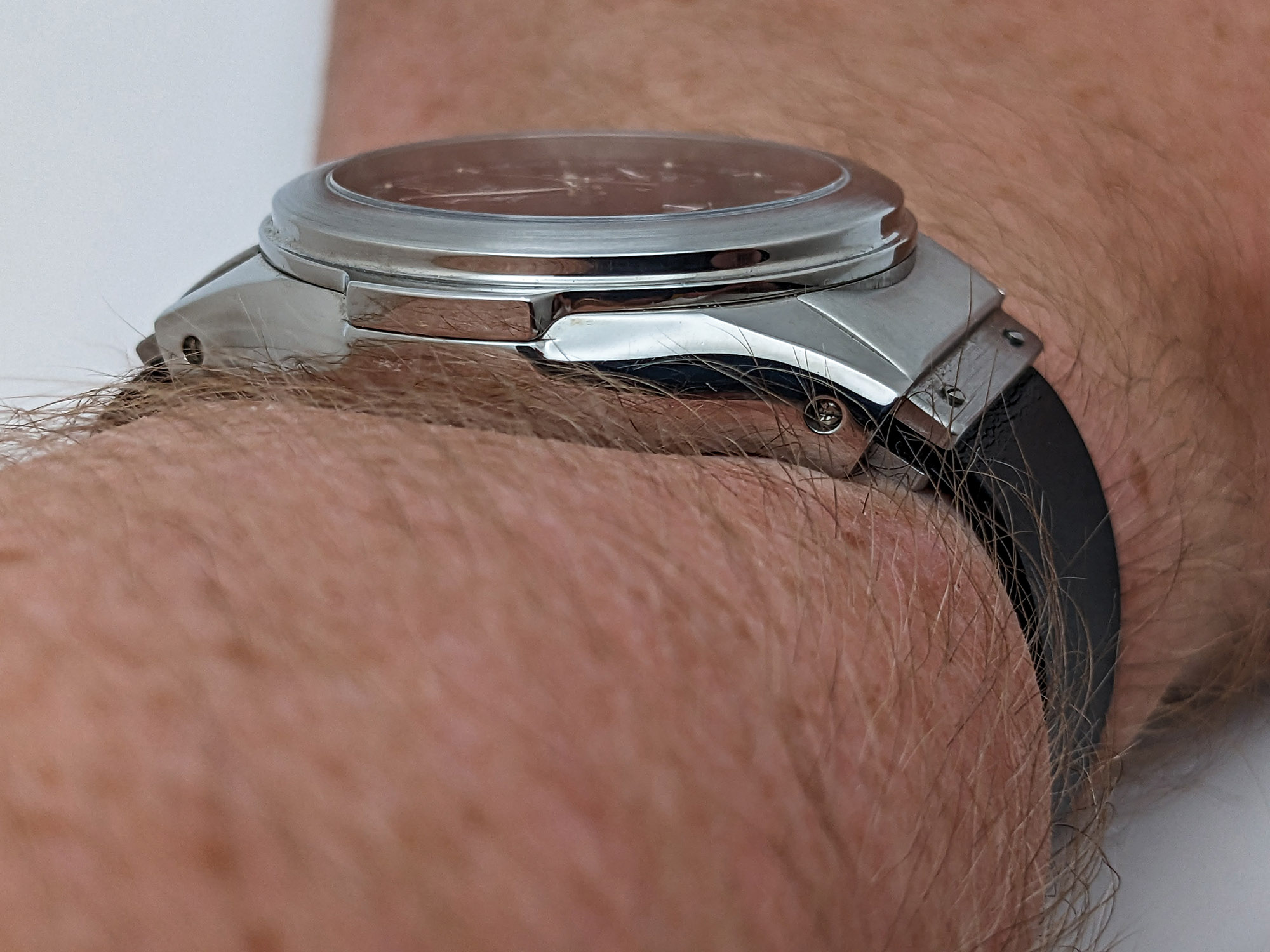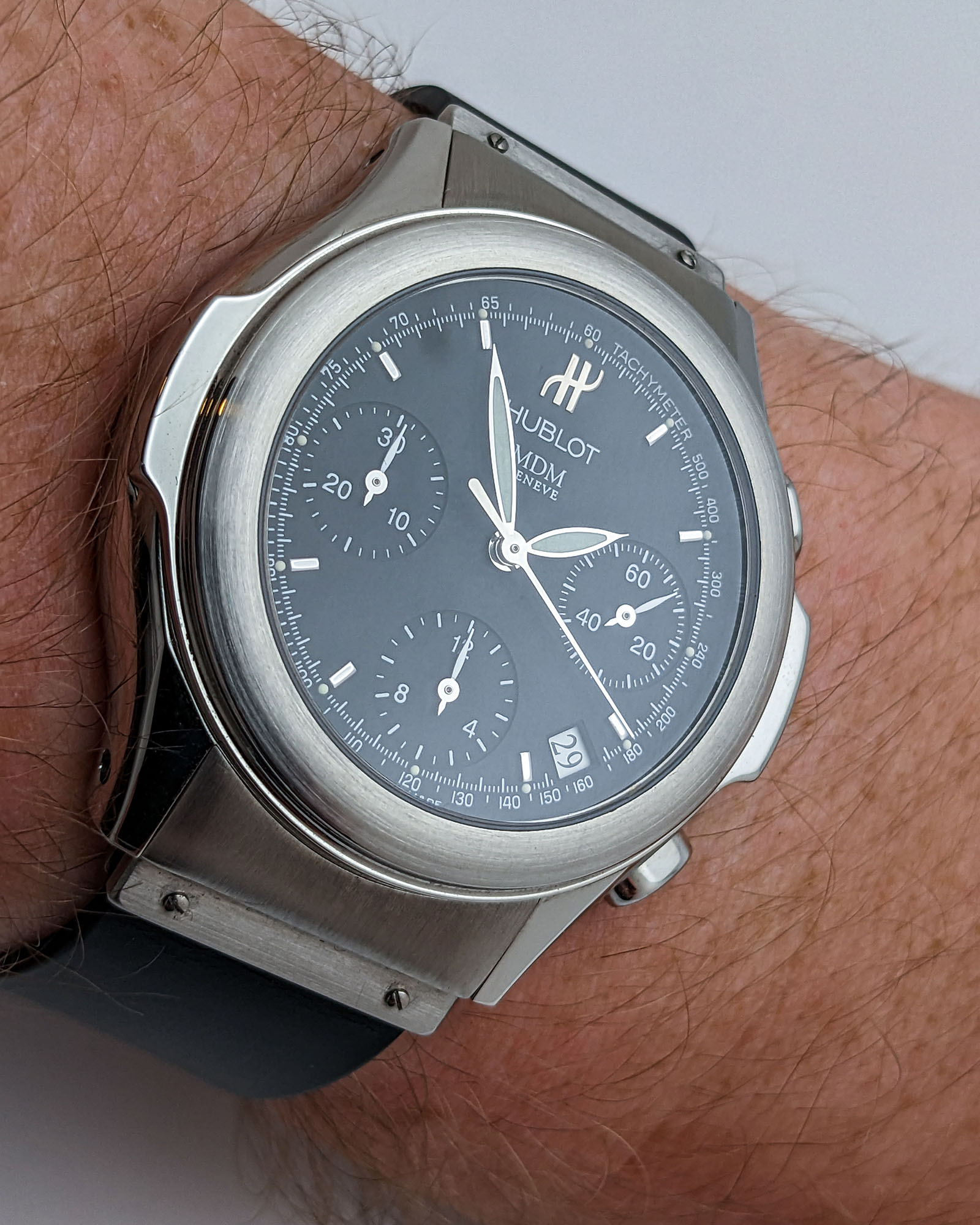
One of the most important design challenges for any manufacturer, whether it be a watch brand, an automaker, a clothing company, or a maker of almost any other form of consumer goods, is the establishment of a firm and recognizable brand identity. Ideally, the public should be able to spot a product from across a room and immediately identify it among its competitors. As such, watch brands tend to gravitate toward creating a clear and concise brand DNA, both giving consumers a recognizable look on the wrist and establishing the kind of person the brand wants to be associated with. However, evolution is founded upon the fact that DNA can change over time, and what happens when a watch brand drastically shifts its DNA overnight? It’s more common than one might think (usually occurring around major leadership changes at brands), and it leads to there being distinctive “eras” in a company’s back catalog. Hublot is one of the strongest examples of this principle in action. When it was founded by Italian entrepreneur Carlo Crocco in 1980, Hublot was truly cutting-edge for its time, combining gold integrated-style cases with rubber straps for a new concept of sporting luxury. After a few years, however, this novelty began to wear off. When famed industry insider Jean-Claude Biver took the helm of the brand in 2005, he introduced the core Big Bang series and set Hublot on the path to becoming the wild, avant-garde nameplate it is today. The middle period between the dawn of the brand and the Biver years is often overlooked, but it contains some of the most interesting and unusual efforts in Hublot’s history. This 2000 Hublot MDM Elegant Chronograph is a prime example of the joys to be found by delving into these different eras of watch brand history, with a sleek and handsome style broadly removed from the brand’s current DNA.
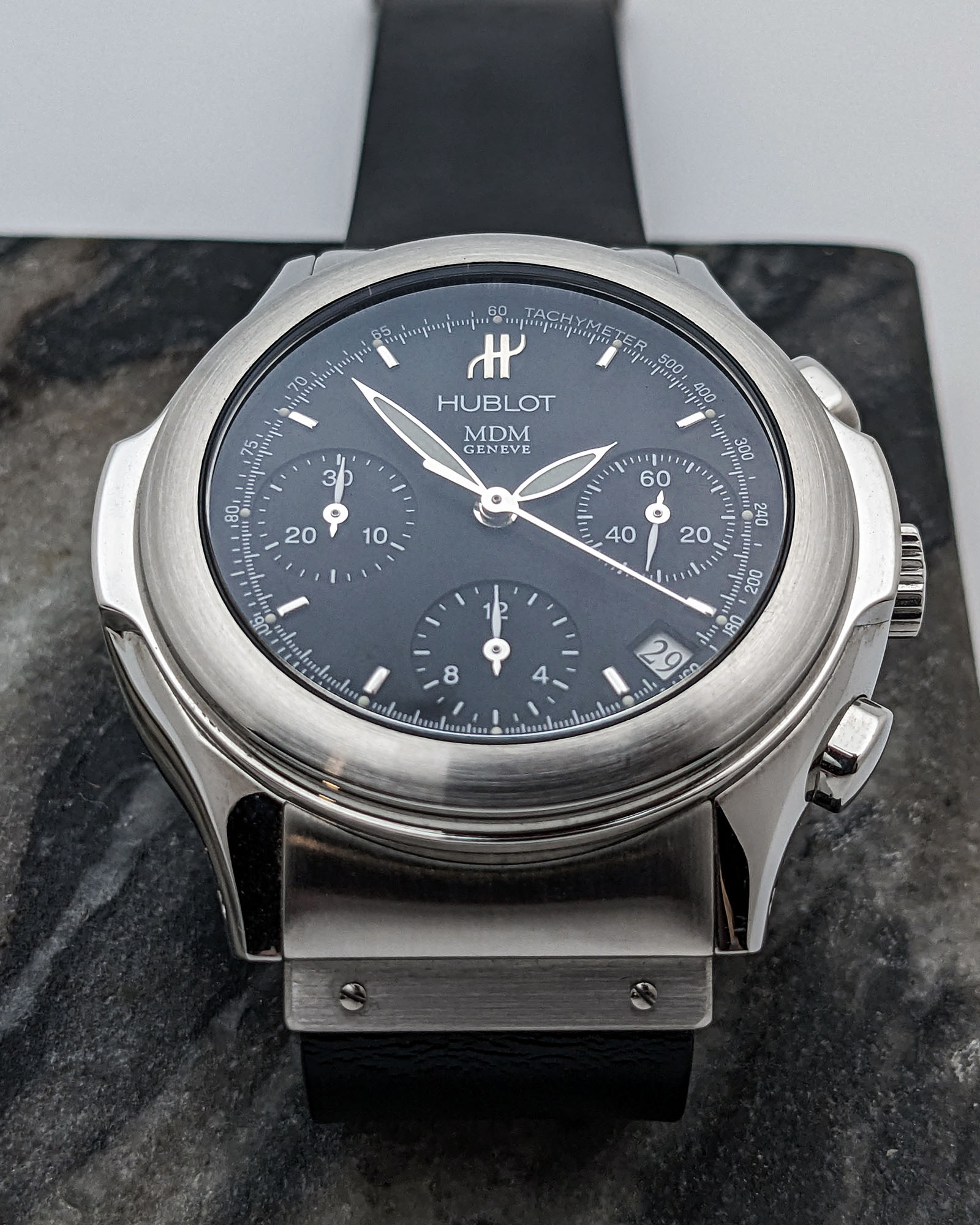
There are many words that can be used to describe modern Hublot. “Bold,” “innovative,” and “avant-garde” immediately spring to mind, among many others. Even the brand’s staunchest supporters would be hard-pressed to use the term “elegant,” however. Through the ‘90s and early 2000s, though, Hublot was on a markedly different track, combining its still-subversive integrated rubber strap concept with a series of more refined and subtle designs. The Hublot MDM Elegant was one of the most prominent designs in a surprisingly varied catalog during those years, and while it carries a number of Hublot hallmarks, it’s a very different animal from the brand’s modern output.
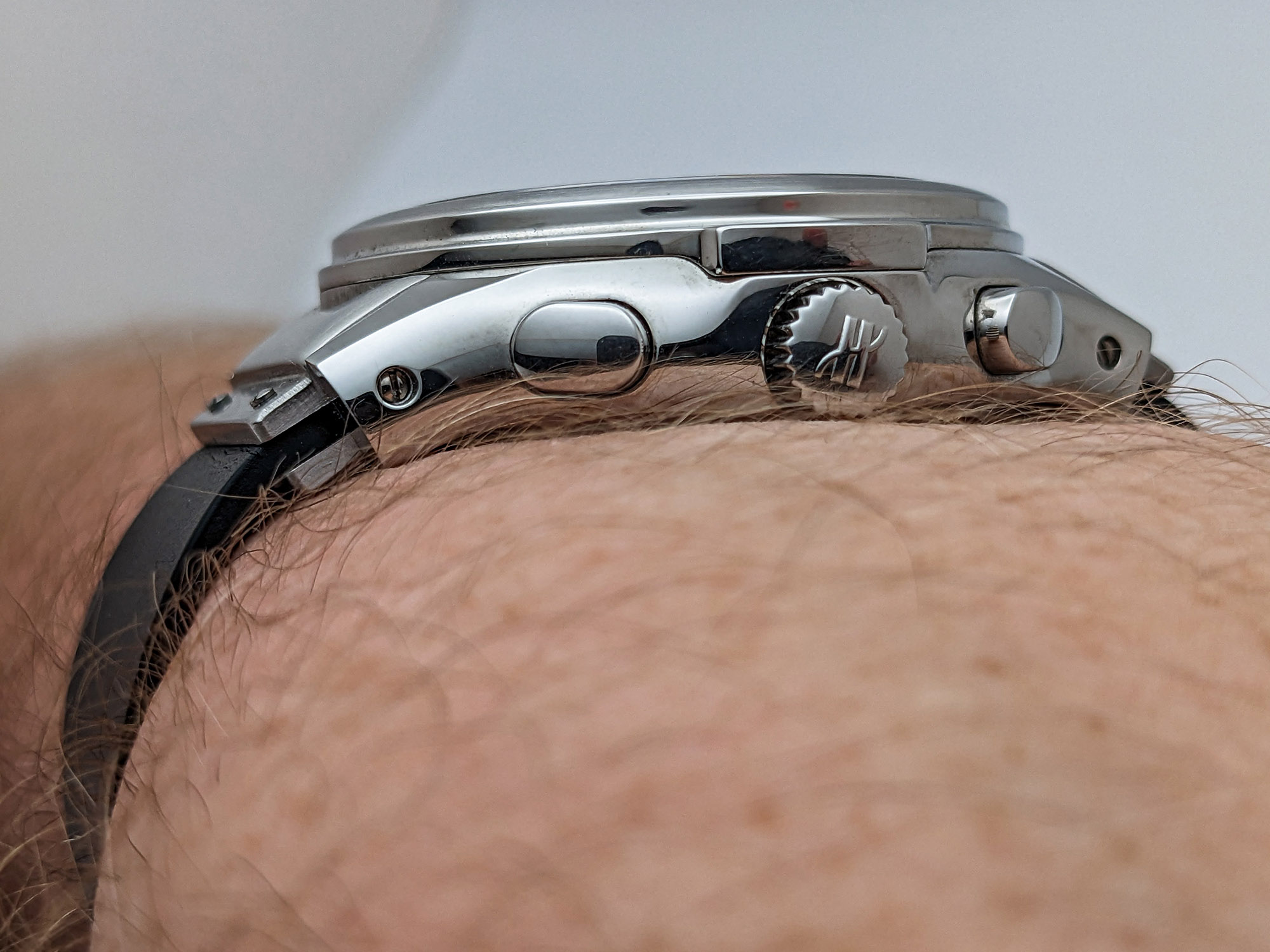
As a start, the Hublot MDM Elegant Chronograph is impressively compact. The stainless steel case measures in at a modest 40mm-wide and wears smaller than the numbers suggest, thanks to a relatively small dial aperture. While the overall case shape shares some similarities with the modern Hublot Classic Fusion series, the MDM Elegant Chronograph is a softer, more rounded design than anything currently produced by the brand. Like the Classic Fusion, this takes a roundabout approach to Genta-esque sports watch design, with a rather conventional tapering lug profile coupled to a perfectly flush-fitting steel endlink that screws into the classic smooth black Hublot rubber strap. This design eliminates the Classic Fusion’s angular lug downturn, however, in favor of a more flowing, sloped form. Likewise, the softly rounded case sides are similar to what one would find on the modern Classic Fusion, but here the bulging outward curve is more pronounced and flows into a broader set of polished bezel flanges at 3 o’clock and 9 o’clock. It’s the bezel itself that truly sets the MDM Elegant Chronograph apart, though. There’s no hint of Hublot’s familiar H-pattern bezel screws or even the original ‘80s-style Hublot bezel rivets here, and instead, this broad, gently sloping bezel offers cleanly uninterrupted radial brushing. Additionally, the bezel adds a double-stepped structure here, surrounding the main bezel with a narrow polished outer ring that flares seamlessly outward into the nautically-inspired polished bezel side flanges. Even the chronograph pushers take a more rounded shape than the brand’s current design philosophy, with sleekly polished oval profiles. Taken as a whole, this is a less aggressive, more mature reimagining of the ur-Hublot case design, but not without its own sort of visual punch. Where this subtler kind of flash really shines through is in the finishing. The majority of this case, from the rounded case sides to the bezel flanges, is brilliantly mirror-polished, but Hublot gives this brighter look on the wrist a sporting edge with brushing for the bezel and the end links. Unlike some of its antecedents, the Hublot MDM Elegant Chronograph is a proper dyed-in-the-wool sports chronograph as well, boasting a screw-down crown and a solid 100 meters of water resistance.
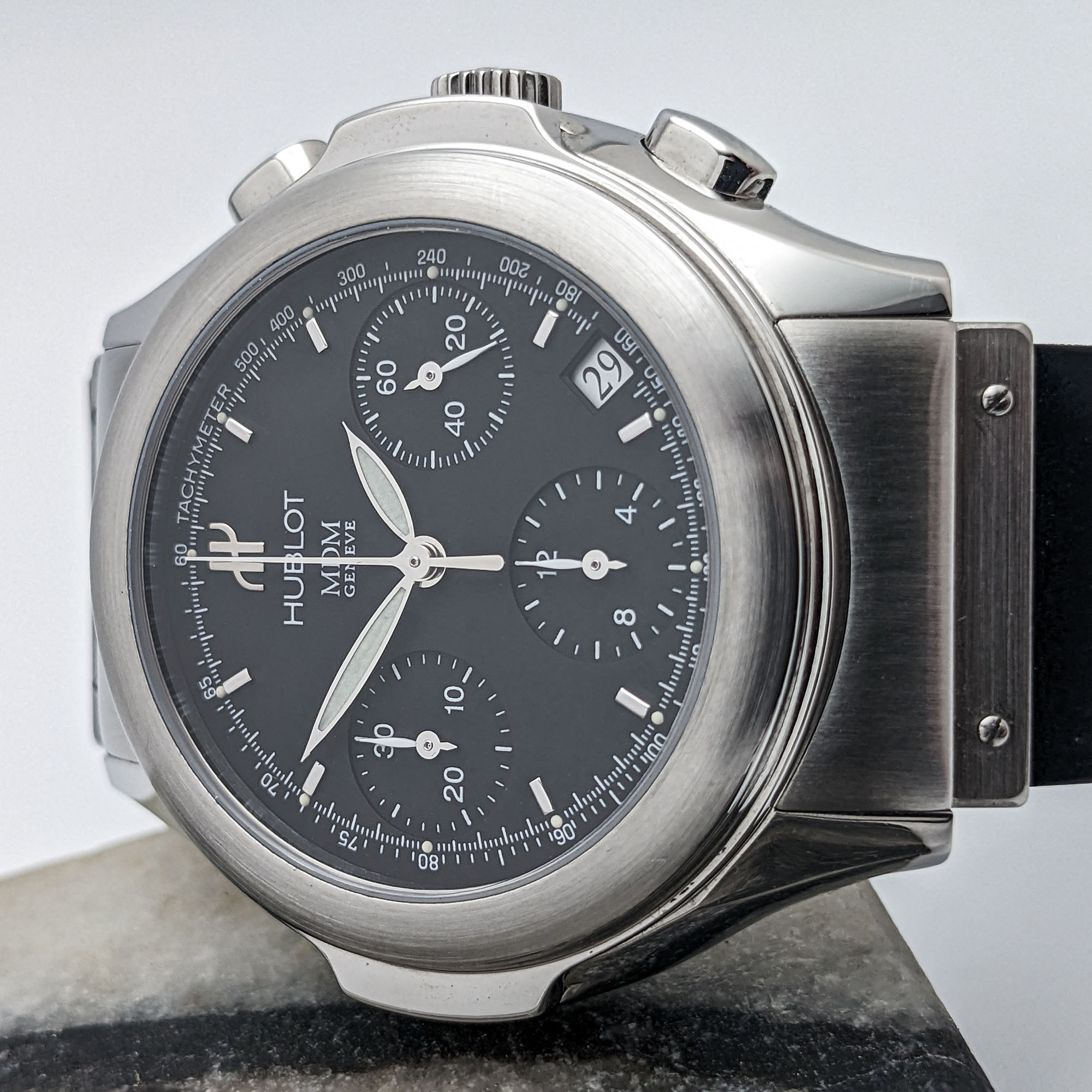
Hublot offered the MDM Elegant Chronograph with a broad array of dial options over the years, including rich sapphire blue sunbursts, deep and intriguing burgundy red dials, classic silver dials, mother-of-pearl dials, screaming glossy hazard yellow examples, and a choice between bold printed Arabic numerals and a set of diminutive applied indices. This comparatively restrained matte black dial example is one of the most common variants produced, and perhaps the one best suited to wear the “Elegant” moniker. Compared to modern Hublot’s array of avant-garde skeleton dials, hyper-minimal gloss black layouts, and ultra-sporty bold designs, this feels refreshingly straightforward and demure. The leaf handset is far removed from the angularity usually associated with the brand, as is the set of rounded, undersized polished indices. An outer tachymeter scale further visually compresses the dial on the wrist while giving this watch a sportier appearance, while a sizeable polished “H” emblem at 12 o’clock might be the only giveaway to casual enthusiasts that this is in fact a Hublot. Each of the three recessed subdials is on the smaller side, and as such can come off as a touch wide-set, but are all easily legible in practice and help to visually unify the design with a set of glossy white leaf hands. The only truly contentious design choice here is a white date window at 4:30, but mismatched date displays were far more common in this era of watchmaking than they are today.
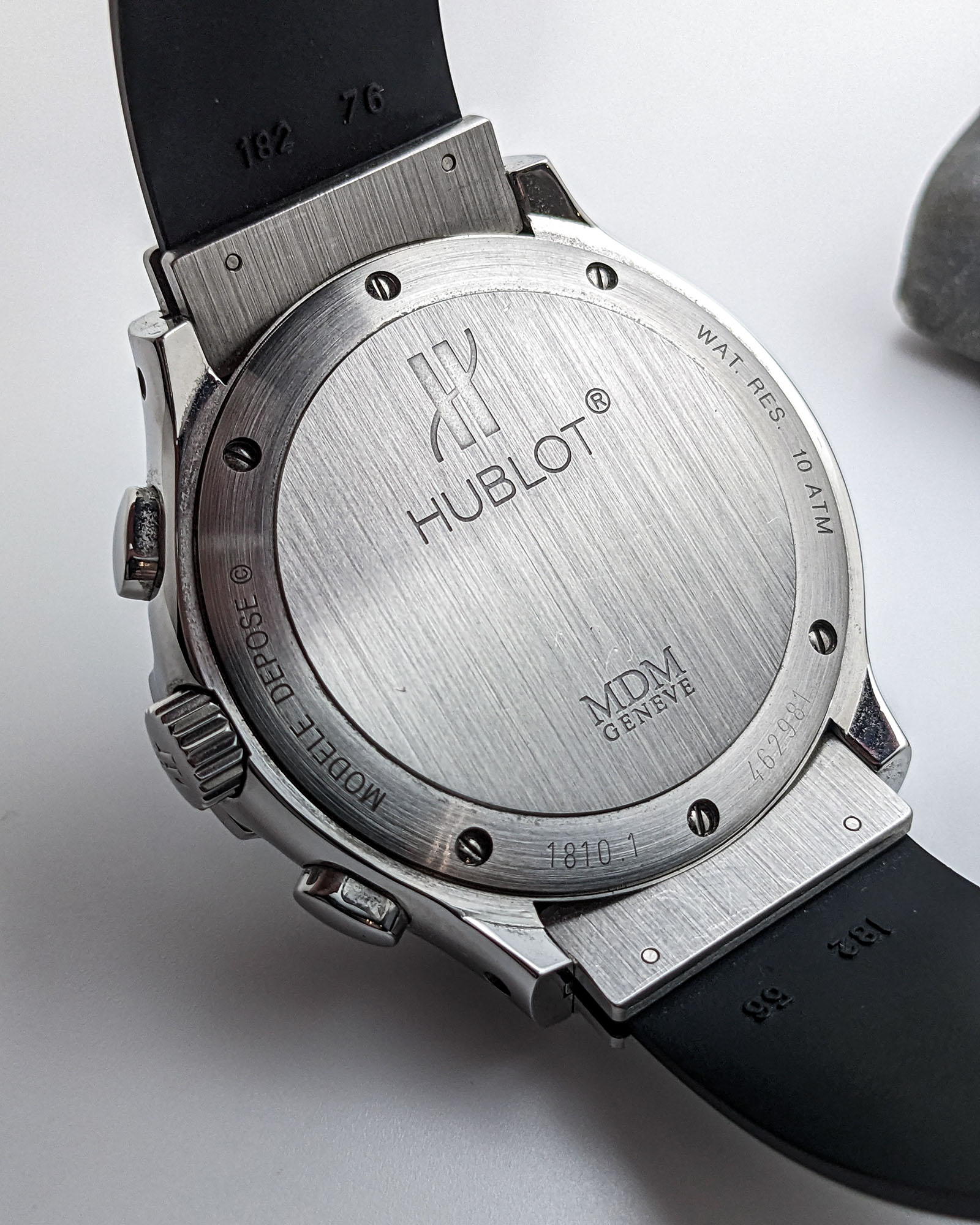
Although Hublot still outsources several of its movements today, the Hublot MDM Elegant Chronograph comes from an era before the company began producing its own movements. As such, its modular ETA 2892-A2 automatic movement with a Dubois-Depraz 2020 chronograph module may or may not come as a surprise to modern enthusiasts. It may lack some of the prestige of Hublot’s later, wilder in-house movement designs, but this is a solidly dependable platform and one that’s easily serviceable by a wide variety of watchmakers. Some purists may decry the modular platform as well, but similar modular designs have been used in recent years by brands ranging from TAG Heuer to Tudor, and Dubois-Depraz itself has a long and storied history of producing high-end chronographs for a plethora of watchmakers. This particular model is proof positive of how well these movements can perform when looked after, running at +4 seconds per day and offering a sharp, precise chronograph pusher feel. The 42-hour power reserve and 28,800 bph beat rate do come off as decidedly pedestrian by modern standards, however.

The strap is where the Hublot MDM Elegant Chronograph carries its closest link to the Hublot design language of today. Both the core Big Bang design and the Classic Fusion family use similar black rubber straps, visually tying each model back to the original Hublot silhouette of 1980. This thin, flexible rubber strap design is supremely supple and comfortable on the wrist, with a lightweight butterfly clasp that makes for a seamless fit. However, these straps have to be cut to fit the wearer’s wrist, which can make sourcing a vintage model tricky for larger-wristed enthusiasts, but Hublot does still produce replacement straps for these models.
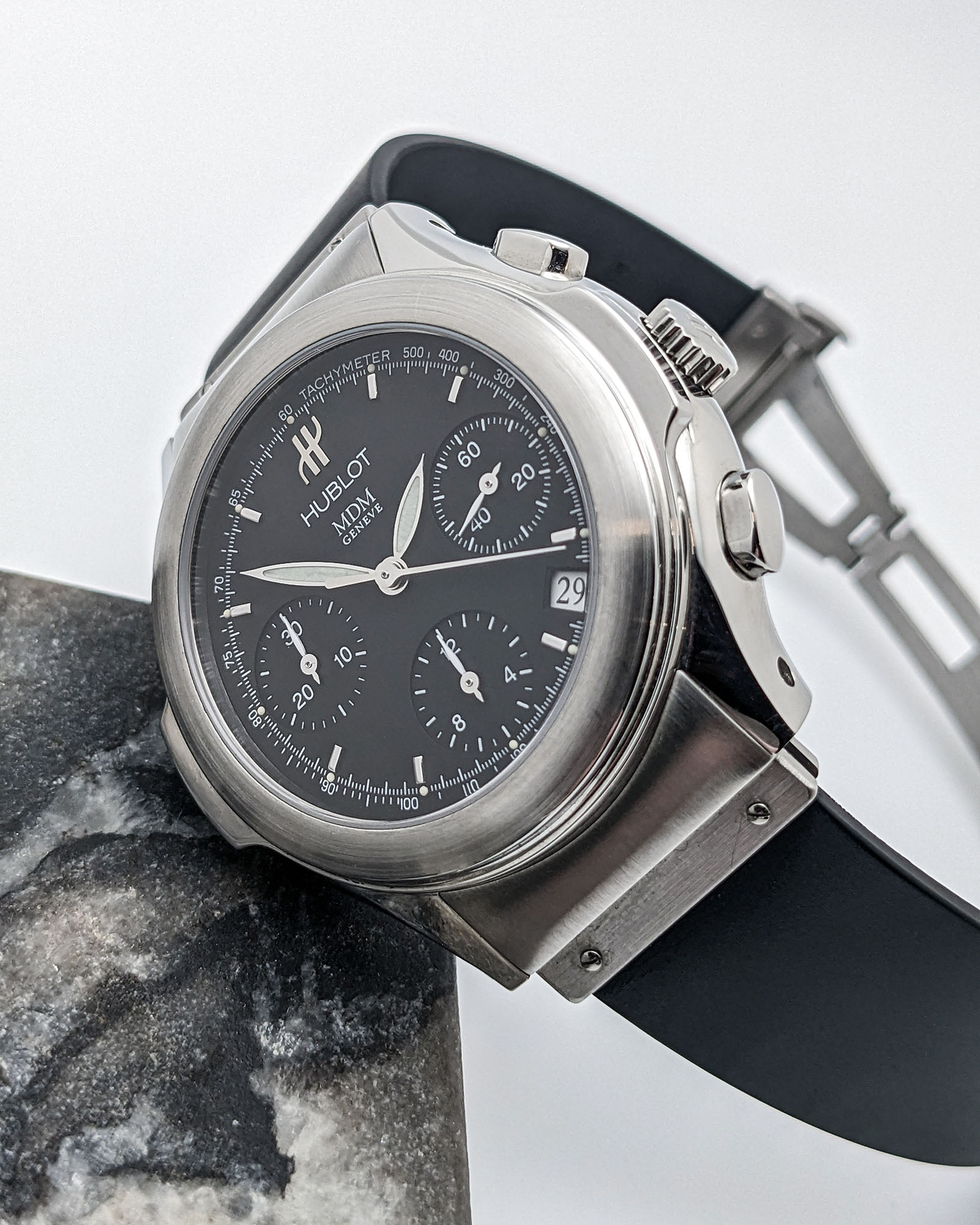
It’s hard to deny that the 2000 Hublot MDM Elegant Chronograph bears little resemblance to the brand’s contemporary stylistic DNA, but it’s a stylish and handsome reminder that delving into earlier and less well-traveled areas of a watchmaker’s evolution can yield truly compelling results. This is one of the most restrained, mature designs in the brand’s famously varied archive, and one that I’m personally proud to have in my collection.

